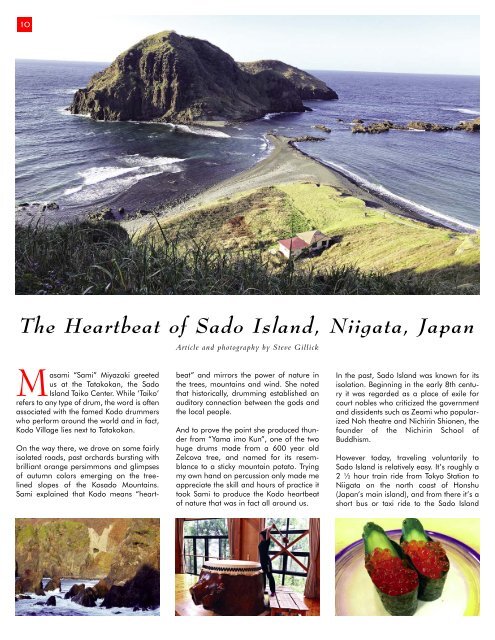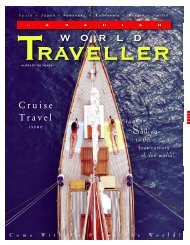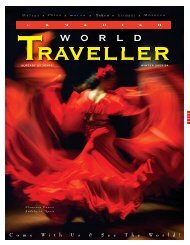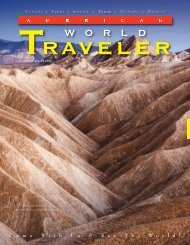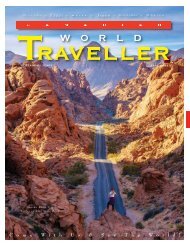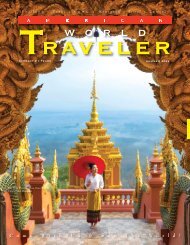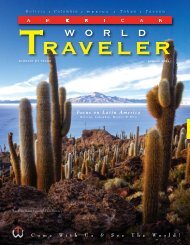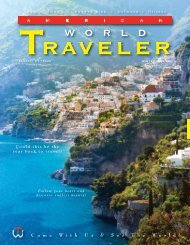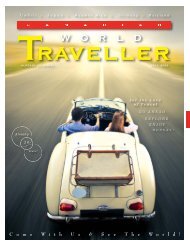Canadian World Traveller Winter 2019-20 Issue
Now in our 18th year of publishing, Canadian World Traveller explores the culture and history of worldwide destinations, sharing the adventure of discovery with our readers and motivating them to make their travel dreams a reality. Published quarterly, CWT helps sophisticated, independent Canadian travellers choose their next destination by offering a lively blend of intelligent, informative articles and tantalizing photographic images from our World’s best destinations, cruises, accommodations and activities to suit every traveller's taste.
Now in our 18th year of publishing, Canadian World Traveller explores the culture and history of worldwide destinations, sharing the adventure of discovery with our readers and motivating them to make their travel dreams a reality. Published quarterly, CWT helps sophisticated, independent Canadian travellers choose their next destination by offering a lively blend of intelligent, informative articles and tantalizing photographic images from our World’s best destinations, cruises, accommodations and activities to suit every traveller's taste.
Create successful ePaper yourself
Turn your PDF publications into a flip-book with our unique Google optimized e-Paper software.
10<br />
The Heartbeat of Sado Island, Niigata, Japan<br />
Article and photography by Steve Gillick<br />
Masami “Sami” Miyazaki greeted<br />
us at the Tatakokan, the Sado<br />
Island Taiko Center. While ‘Taiko’<br />
refers to any type of drum, the word is often<br />
associated with the famed Kodo drummers<br />
who perform around the world and in fact,<br />
Kodo Village lies next to Tatakokan.<br />
On the way there, we drove on some fairly<br />
isolated roads, past orchards bursting with<br />
brilliant orange persimmons and glimpses<br />
of autumn colors emerging on the treelined<br />
slopes of the Kosado Mountains.<br />
Sami explained that Kodo means “heart-<br />
beat” and mirrors the power of nature in<br />
the trees, mountains and wind. She noted<br />
that historically, drumming established an<br />
auditory connection between the gods and<br />
the local people.<br />
And to prove the point she produced thunder<br />
from “Yama imo Kun”, one of the two<br />
huge drums made from a 600 year old<br />
Zelcova tree, and named for its resemblance<br />
to a sticky mountain potato. Trying<br />
my own hand on percussion only made me<br />
appreciate the skill and hours of practice it<br />
took Sami to produce the Kodo heartbeat<br />
of nature that was in fact all around us.<br />
In the past, Sado Island was known for its<br />
isolation. Beginning in the early 8th century<br />
it was regarded as a place of exile for<br />
court nobles who criticized the government<br />
and dissidents such as Zeami who popularized<br />
Noh theatre and Nichirin Shionen, the<br />
founder of the Nichirin School of<br />
Buddhism.<br />
However today, traveling voluntarily to<br />
Sado Island is relatively easy. It’s roughly a<br />
2 ½ hour train ride from Tokyo Station to<br />
Niigata on the north coast of Honshu<br />
(Japan’s main island), and from there it’s a<br />
short bus or taxi ride to the Sado Island


